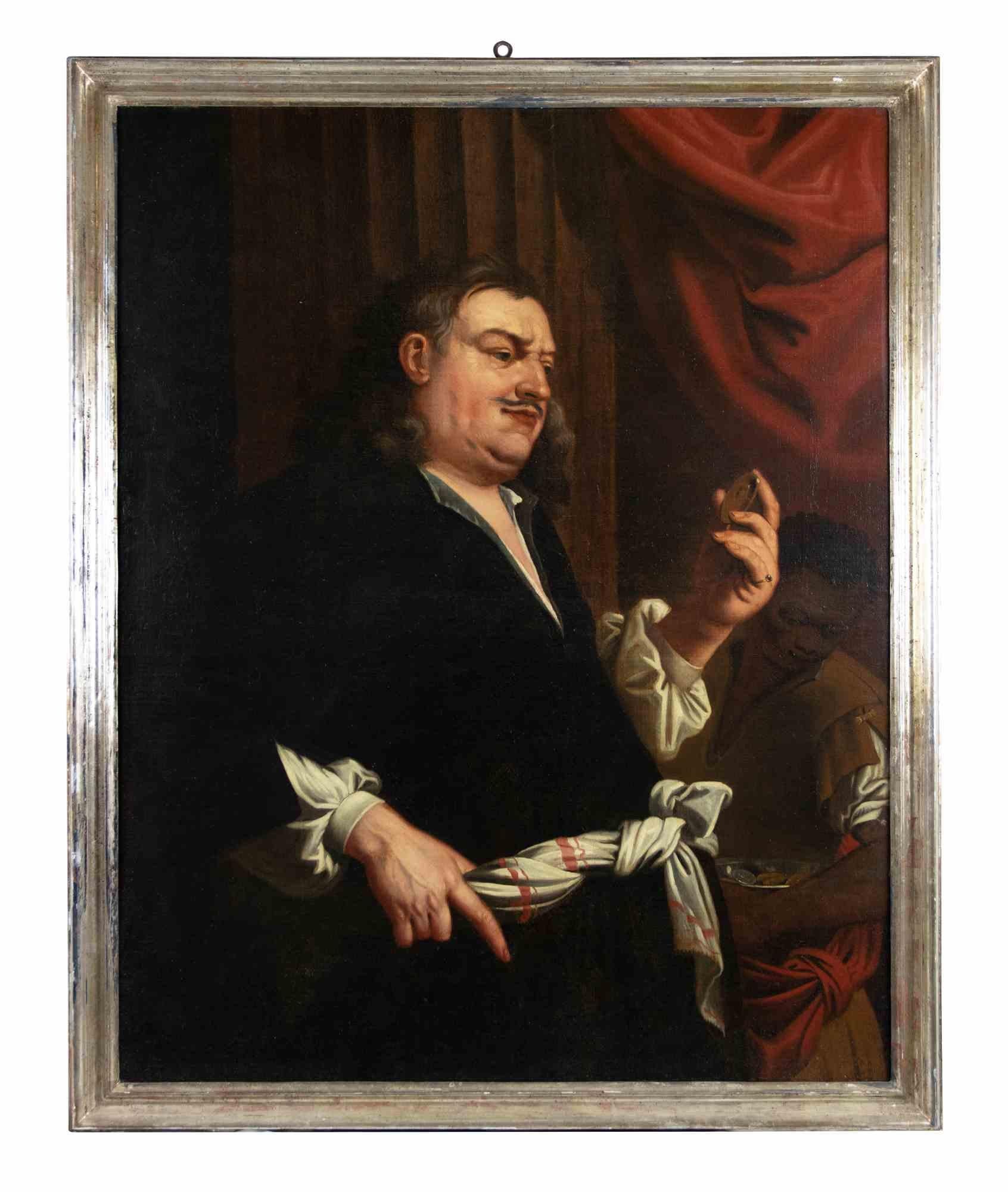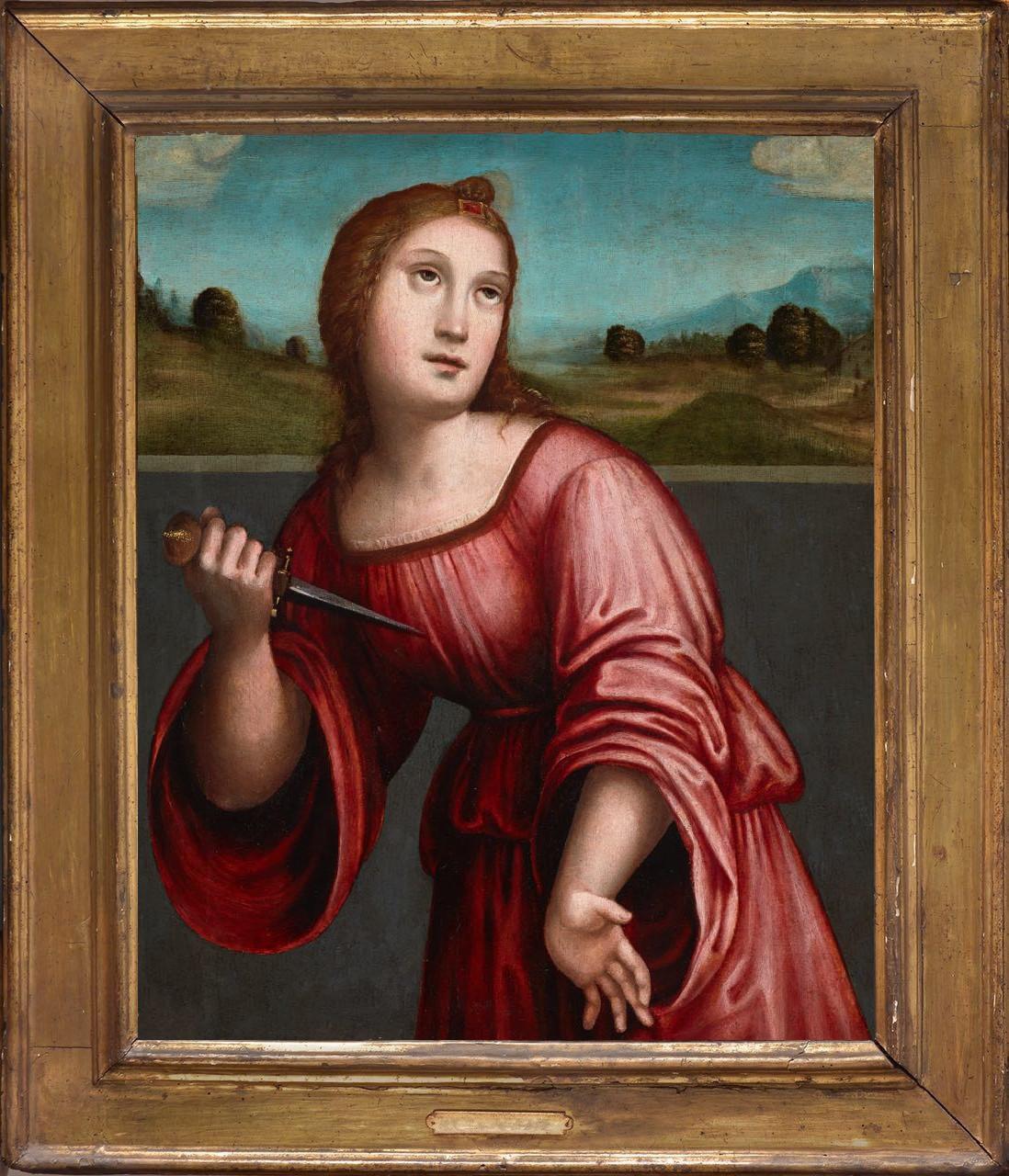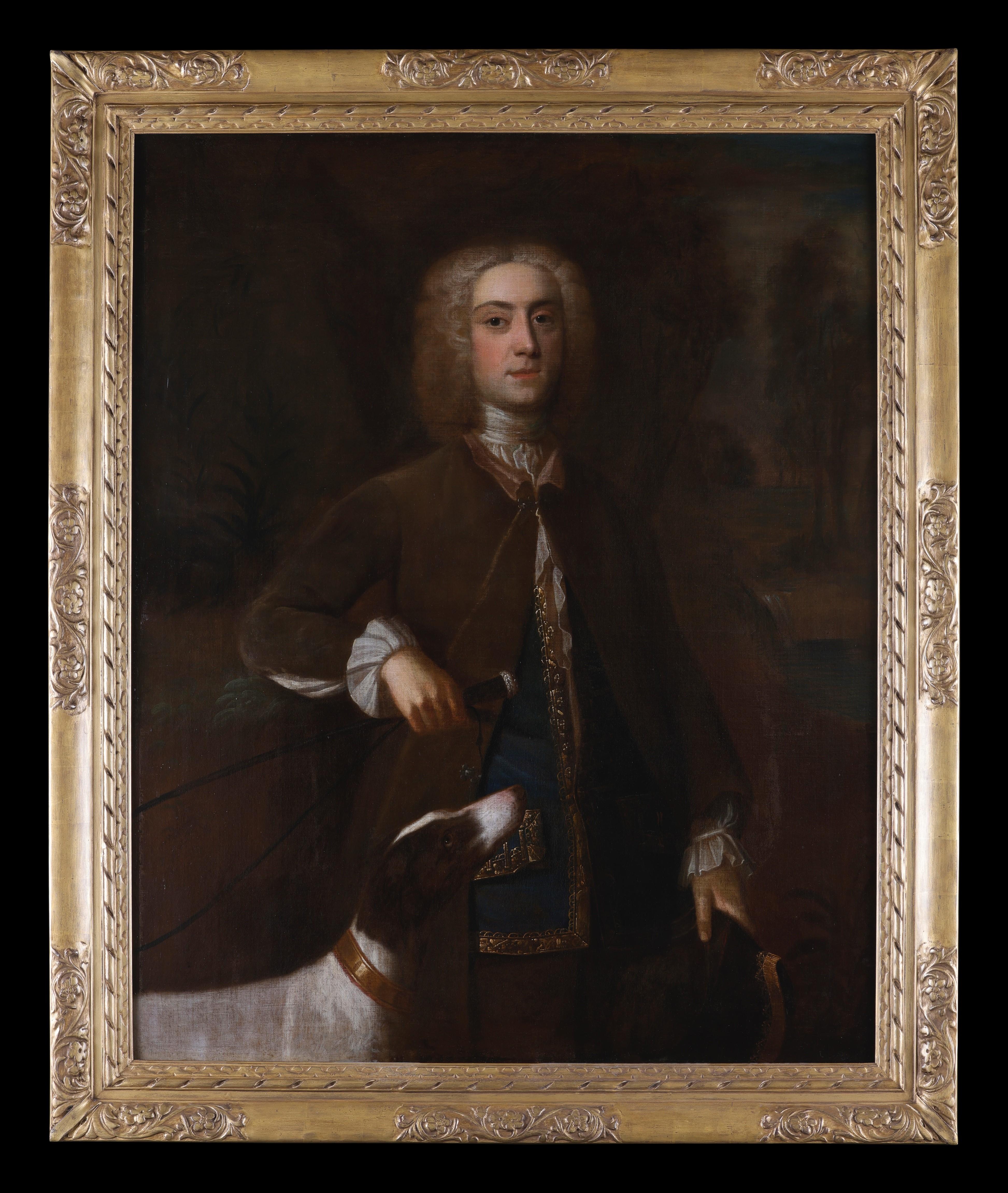Items Similar to 17th Century French School, Saint John the Baptist, oil on copper
Video Loading
Want more images or videos?
Request additional images or videos from the seller
1 of 10
Unknown17th Century French School, Saint John the Baptist, oil on copperciirca 1680
ciirca 1680
About the Item
17th Century French School
Saint John the Baptist in a landscape
oil on copper
17 x 11.5 cm
In good condition except very small loss of painting in the lower left part
In a modern frame : 21.8 x 16.5 cm
This small painting is an interesting and charming representation of Saint John the Baptist.
It combines the traditional iconographic elements of this major figure in Christianity: He is holding the traditional staff adorned with a band bearing the words "ecce agnus dei", here is the Lamb of God. This lamb can be found to his lower left. He is traditionally dressed in a garment of animal skin and a red cape. Above all, he is pointing to the Christ, whose tiny silhouette can be seen on the left-hand edge.
What is more surprising is that here he is not wearing the traditional beard but is depicted as a young man.
The landscape in the background is also particularly charming. The cool blue and green tones are a perfect counterpoint to the red-dominated figure of the saint.
- Creation Year:ciirca 1680
- Dimensions:Height: 6.7 in (17 cm)Width: 4.53 in (11.5 cm)
- Medium:
- Movement & Style:
- Period:1680-1689
- Condition:
- Gallery Location:Paris, FR
- Reference Number:
About the Seller
5.0
Gold Seller
These expertly vetted sellers are highly rated and consistently exceed customer expectations.
Established in 2018
1stDibs seller since 2019
210 sales on 1stDibs
Typical response time: <1 hour
- ShippingRetrieving quote...Ships From: Paris, France
- Return PolicyA return for this item may be initiated within 14 days of delivery.
More From This SellerView All
- Spanish School 19th century, Santa Justa and Santa Rufina, oil on canvasLocated in Paris, FRSpanish School of the 19th Century Santa Justa and Santa Rufina Oil on canvas 40 x 27 cm In quite good condition, the paint surface presents numerous crack...Category
1840s Old Masters Figurative Paintings
MaterialsOil
- French Romantic School, Portrait of a young priest, dated 1860 oil on canvasLocated in Paris, FRFrench Romantic School, Portrait of a young priest, 1860 Signed (illegible) and dated 1860 oil on canvas 21.5 x 16 cm In a modern frame : 35 x 29 cmCategory
1860s Portrait Paintings
MaterialsOil
- Lucien-Victor Guirand de Scévola (1871-1950) Portrait of Lady, oil sketch signedBy Lucien-Victor Guirand de ScévolaLocated in Paris, FRLucien-Victor Guirand de Scévola ( 1871 – 1950) Portrait of a lady, a sketch signed lower right Oil on canvas transfered on cardboard 25 x 18 cm oval Framed : 31 x 24.5 cm This port...Category
1920s Art Deco Portrait Paintings
MaterialsOil
- Attributed to Charles de Steuben (1788-1856) Portrait of a man, oil on canvasLocated in Paris, FRAttributed to Charles de Steuben (1788-1856) Portrait of a man, oil on canvas 22 x 18 cm In a modern frame : 35,5 x 31,5 cm The attribution of this small portrait to Charles de St...Category
1840s Romantic Portrait Paintings
MaterialsOil
- French School 19th Century, Portrait of a Soldier, oil on canvasLocated in Paris, FRFrench School 19th Century, Portrait of a Soldier, oil on canvas transfered on panel 23.5 x 15.5 cm framed : 32.x 23.8 cm This small painting, undoubtedly a painted sketch, is int...Category
1890s Romantic Portrait Paintings
MaterialsOil
- French Romantic School, 19th Century, Manly head of bearded man, oil on canvasLocated in Paris, FRFrench Romantic School 19th Century Manly head of bearded man oil on canvas 46 x 37.8 cm In fairly good condition, some inpaintings visible under UV light, mainly in the backgrounds ...Category
1850s Romantic Portrait Paintings
MaterialsCanvas, Oil
You May Also Like
- Fine 17th Century Italian Old Master Oval Portrait of Lady on Copper Wooden FrmLocated in Cirencester, GloucestershirePortrait of a Lady (female saint?) Italian School, 17th century oil on copper, framed frame: 9 x 8 inches board: 5 x 4 inches provenance: private collection condition: very good and ...Category
17th Century Old Masters Figurative Paintings
MaterialsOil
- A Rich Merchant - Painting by Unknown - 18th CenturyLocated in Roma, ITA rich merchant is an original old master artwork realized in the 18th Century. Mixed colored oil painting on canvas depicting a merchant looking at a coin in his left hand. Provena...Category
18th Century Old Masters Figurative Paintings
MaterialsOil
- Lucretia, by Giacomo Raibolini Francia. Detto il Francia. Oil on panel, framedLocated in Brooklyn, NYGiacomo used to paint with his brother Giulio, identifying their works with the monogram «I I». The strong influence of his father, Francesco, is undeniable in all his works, althoug...Category
16th Century Old Masters Figurative Paintings
MaterialsOil, Wood Panel
- Portrait of Jean-Baptiste Greuze, painted on linen by his daughter Anna GreuzeLocated in PARIS, FRThis replica of the last self-portrait of Jean-Baptiste Greuze painted in 1804, executed by his daughter Anna at her father's side and recently rediscovered, provides us with a poignant image of the great artist, represented with panache despite the disillusions of life. 1. Jean-Baptiste Greuze Jean-Baptiste Greuze was the sixth child of a roofer from Tournus and retained a certain rusticity in his behaviour from his provincial childhood, beyond his taste for describing picturesque scenes of the countryside. He initially started training with a little-known painter from Lyon, Charles Grandon, before his genius was recognised in Paris where he became a full-time student of the Académie (of Painting) in 1755. He exhibited his work for the first time at the Salon during the summer of 1755, before leaving on a trip to Italy in the company of Louis Gougenot, abbot of Chezal-Benoît. Upon his return to Paris, Greuze became a prolific painter, participating widely in the Salons held between 1759 and 1765, to which he sent no less than 63 paintings: numerous genre scenes (The Marriage Contract, The Beloved Mother), but also portraits of his family circle, of courtiers and art lovers, or of his colleagues. The Academy closed the doors of the Salons to him in 1767 for not having produced his reception piece within six months of his reception, as was the tradition. He worked actively on this painting (Emperor Severus rebukes Caracalla, his son, for trying to assassinate him ) until the summer of 1769, tackling historical and mythological subjects for the first time. Once this was completed, he was then fully admitted to the Academy, but as a genre painter, and not as an historical painter, which had been one of the greatest humiliations of his life. Greuze then refused any participation in events organised by the Academy or its successor, the Academy of Fine Arts until 1800. Abandoning history painting, he gave a new twist to genre scenes, bringing them closer to history painting, as in this pair of canvases which constitutes some of his masterpieces: The Paternal Curse: The Ungrateful Son and The Paternal Curse: The Punished Son . Married in 1759 to Anne-Gabrielle Babuti, the daughter of a Parisian bookseller, his marriage was unhappy and his wife probably frequently unfaithful. The institution of divorce enabled him to record their separation in 1793, keeping his two daughters Anna-Geneviève, born in April 1762, and Louise-Gabrielle, born in May 1764, with him. Little is known about his daughter Anna except that she was herself a painter and lived with her father until his death. It is likely that most of the paintings she produced up to that date were attributed to her father, whose technique she shared to a great extent, making it extremely difficult to establish an autonomous corpus of her paintings. Greuze died in his studio at the Louvre on March 21st 1805. The attention paid to the expressivity of his characters and the emotional charge they convey enabled Jean-Baptiste Greuze to enjoy immense popularity with the eighteenth-century public, and they still constitute Greuze's true modernity. As the artist said, "I dipped my brush in my heart". Greuze was also an exceptional draughtsman and a portraitist of immense talent and exceptional longevity who painted both the Dauphin (the son of Louis XV and father to Louis XVI) and the young Napoleon Bonaparte. 2. Greuze's self-portraits Greuze was very much influenced by Dutch paintings during all his life. While the source of his inspiration for genre scenes can be found in Gerard Dou...Category
Early 1800s Old Masters Portrait Paintings
MaterialsLinen, Oil
- Portrait of a Gentleman with his Dog - Possibly Abraham Tucker. Oil on CanvasBy Enoch SeemanLocated in St. Albans, GBEnoch Seeman - 1894 - 1744 An excellent example of Seeman's work. It is typically unsigned as was the case of many portraits of that time. A three quarter length portrait showing a r...Category
1730s Old Masters Portrait Paintings
MaterialsOil
- Antique Spanish Old Master Oil on Wood Panel, Head Portrait of ChristLocated in Cirencester, GloucestershireArtist/ School: 18/19th Century Spanish School Title :Head study of Christ Medium: oil painting on wood panel, period gilt framed panel : 6 x 5 inches Provenance: private collect...Category
18th Century Old Masters Figurative Paintings
MaterialsOil
Recently Viewed
View AllMore Ways To Browse
Silhouette Portrait
Antique Copper Painting
Blue John Antique
17th Century Copper
The Baptist
Red Cape
Antique Beard
Antique Silhouette Frames
Antique Framed Silhouette
Antique Framed Silhouettes
John Baptist
John The Baptist
Lamb Oil Painting
John The Baptist Painting
Old Master Portrait Young Man
17th Century Man Portrait
17th French Portrait Oil
Lamb Skin




